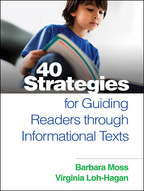40 Strategies for Guiding Readers through Informational Texts
Barbara Moss and Virginia Loh-Hagan
New to This Edition
- Now features more strategies, including 16 that are completely new.
- Explicit links throughout to the Common Core State Standards (CCSS) and other current standards.
- Two additional strands of activities: Reading Closely and Discussion.
- Numerous new and revised reproducible tools—all downloadable.
“I already use the prior edition of this book to plan my weekly informational text lessons efficiently, but the new edition is even better. It is opening my eyes to even more possibilities to better serve the needs of my students. The strategies are presented in a clear format that can be easily adapted to any curriculum, and are up to date with the CCSS. Classroom teachers, resource teachers, and intervention specialists can use the strategies in whole-class or small-group instruction. When these strategies are implemented, students of all levels are engaged in meaningful discussions and writing activities.”
—Arlene Rodriguez Sanchez, MEd, third-grade teacher and reading specialist, San Diego Unified School District
“Teachers will find this book a treasure trove of practical, research-based best-practice strategies. 40 Strategies for Guiding Readers through Informational Texts builds on the previous edition with additional strategies that utilize close reading, citing text evidence, synthesizing information across sources, and text-dependent questions. This is definitely the right book at the right time. It will be useful for staff development and as a supplemental textbook in literacy methods classes.”
—Terrell A. Young, EdD, Department of Teacher Education, Brigham Young University
“This is one of the best books I have seen for supporting the explicit instruction of informational texts. The authors provide an easy-to-use guide for teachers at any grade level, including classroom examples and authentic text recommendations. Each research-based strategy is presented alongside corresponding Common Core standards. This professional resource is the one I will recommend to my colleagues and teacher candidates, no matter what curricular materials they currently use.”
—Julie Barkley, MA, academic coach, St. Cloud School District, Minnesota
Table of Contents
IntroductionI. Getting Started Strategies
Strategy 1. Planning a Lesson with Informational Text
Strategy 2. Understanding and Evaluating Informational Texts
Strategy 3. Assessing Text Complexity
Strategy 4. Shared Reading and Text Feature Search
II. Building Background Strategies
Strategy 5. Anticipation Guide
Strategy 6. KWHL: K = (What I Know), W = (What I Want to Know). H = (How I Will Find Out), L = (What I Learned)
Strategy 7. KLEW: K = (What I Know), L = (What I Learned), E = (What Evidence Do I Have for My Learning?), W = (What Additional Questions or Wonderings Do I Have?)
Strategy 8. Table of Contents Prediction
Strategy 9. Imagine, Elaborate, Predict, and Confirm
III. Vocabulary Strategies
Strategy 10. Word Map
Strategy 11. SLAP: S = (Say the word and write it here.), L = (Look for context clues. List them here.), A = (Ask myself what it means and write it here.), P = (Put the synonym in the sentence and write it here. Does it make sense? If not, start over with steps 3 and 4.)
Strategy 12. Root Wheel
Strategy 13. List–Group–Label
Strategy 14. Word Sort
Strategy 15. Semantic Feature Analysis
IV. Reading Closely Strategies
Strategy 16. Close Reading
Strategy 17. Close Thinking
Strategy 18. Text Annotation
Strategy 19. Text Dependent Questions
Strategy 20. Thinking Aloud
Strategy 21. Sticky Notes Bookmark
V. Comprehension Strategies
Strategy 22. Study Guide
Strategy 23. Four Box Comment Card
Strategy 24. I Chart
Strategy 25. CAATS: Creator, Assumptions, Audience/User, Time and Place, Significance
Strategy 26. Text Structures
Strategy 27. Interactive Notebook
VI. Discussion Strategies
Strategy 28. Discussion Web
Strategy 29. 4–3–2–1 Discussion
Strategy 30. Intra Act
Strategy 31. Talking Points
Strategy 32. Three Step Interview
Strategy 33. 3 Minute Pause
VII. Writing Strategies
Strategy 34. Readers' Theatre
Strategy 35. Paragraph Writing Frames
Strategy 36. I Used to Think . . . but Now I Know . . .
Strategy 37. Summary Writing
Strategy 38. CLIQUES: CL, Claim; I, Introduction of Quotation; QU, Quotation; E, Explanation of Quotation; S, So What?
Strategy 39. EPIC: E, Evidence; P, Patterns; I, Inquiry; C, Claims
Strategy 40. Two Column Journal
Appendix. Recommended Materials
About the Authors
Barbara Moss, PhD, is Professor of Literacy Education in the School of Teacher Education at San Diego State University. She has taught English and language arts in elementary, middle, and high school settings and has worked as a reading coach. Dr. Moss’s research focuses on the teaching of informational texts at the elementary and secondary levels. She regularly presents at local, state, national, and international conferences and has published numerous journal articles, columns, book chapters, and books. Dr. Moss has served as the Young Adult Literature column editor for Voices in the Middle, a publication of the National Council of Teachers of English.Virginia Loh-Hagan, EdD, is a full-time Lecturer in the School of Teacher Education at San Diego State University, where she is in charge of two teaching credential programs. She is also a curriculum designer, educational consultant, and former K-8 teacher. The author of several academic publications and more than 70 children’s books, Dr. Loh-Hagan serves on several children’s book award committees and is cover editor and columnist for The California Reader, a peer-reviewed journal of the California Reading Association. She is a frequent presenter at state and national conferences.
Audience
Teachers in grades K–12; reading specialists and coaches.Course Use
May serve as a supplemental text in advanced undergraduate- and graduate-level courses.Previous editions published by Guilford:
First Edition, © 2010
ISBN: 9781606239261
New to this edition:
- Now features more strategies, including 16 that are completely new.
- Explicit links throughout to the Common Core State Standards (CCSS) and other current standards.
- Two additional strands of activities: Reading Closely and Discussion.
- Numerous new and revised reproducible tools—all downloadable.
